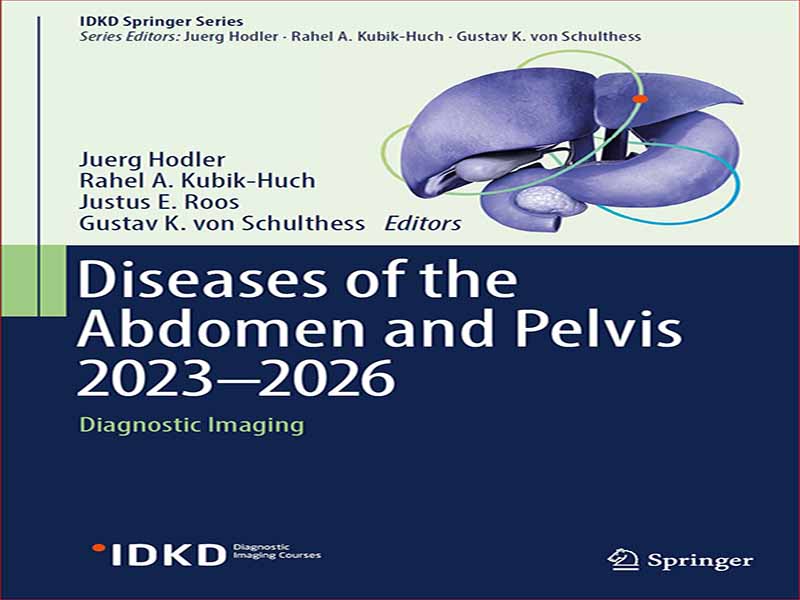- عنوان کتاب: Diseases of the Abdomen and Pelvis 2023-2026
- نویسنده: Diagnostic Imaging
- حوزه: بیماریهای شکم
- سال انتشار: 2023
- تعداد صفحه: 286
- زبان اصلی: انگلیسی
- نوع فایل: pdf
- حجم فایل: 26.5 مگابایت
در یک بیمار بستری شده با ترومای شکمی احتمالی، یک معاینه بالینی طبیعی به خودی خود برای رد آسیب بزرگ داخل شکمی کافی نیست. بنابراین یک روش تصویربرداری باید به طور سیستماتیک به دست آید. بر اساس توصیههای ATLS، یک FAST (ارزیابی متمرکز با سونوگرافی برای تروما) علاوه بر اشعه ایکس لگن، برای تریاژ اولیه بیماران تروما بلافاصله انجام میشود. شش ناحیه به طور کلاسیک در FAST مورد بررسی قرار می گیرند: ربع فوقانی راست، حفره کبدی (کیسه موریسون)، ربع فوقانی چپ (فضای ساب فرنیک)، فرورفتگی طحالی، لگن (شکافت داگلاس) و پریکارد.
به تصویر کشیدن مقدار زیادی مایع داخل صفاقی آزاد در یک بیمار ناپایدار از نظر همودینامیک، انجام لاپاراتومی فوری یا معاینه سی تی را در یک بیمار پایدار ضروری می کند. در یک بیمار با ثبات همودینامیک، یک معاینه FAST نرمال همراه با یک معاینه بالینی طبیعی برای رد آسیب قابل توجه داخل شکمی کافی نیست. در واقع، علاوه بر محدودیت شناخته شده معاینه بالینی شکم تا 34 درصد از آسیب های شکمی می تواند بدون مایع آزاد همراه وجود داشته باشد، 17 درصد از آنها در نهایت نیاز به جراحی یا آمبولیزاسیون آنژیوگرافی دارند. علاوه بر این، معاینه FAST میتواند یک خونریزی خلف صفاقی بزرگ را از دست بدهد. در ترومای جزئی شکمی جدا شده، هیچ معیاری به اتفاق آرا برای انجام یا عدم انجام سیستماتیک CT در غیاب مایع داخل صفاقی آزاد در FAST وجود ندارد. پیشنهاد شده است که افزودن تصویربرداری طبیعی کنار بالین (رادیوگرافی قفسه سینه و لگن، FAST) آزمایشهای خون طبیعی و معاینه بالینی طبیعی میتواند برای ترخیص ایمن بیمار هوشیار بدون مشاهده یا بررسی بیشتر کافی باشد. با این حال، تنها تعداد کمی از بیماران (<20٪) مشکوک به ترومای بلانت شکمی این معیارها را برآورده می کنند. همه دیگر باید تحت بررسی های بیشتر قرار گیرند.
In a patient admitted with a potential abdominal trauma, a normal clinical examination has been shown insufficient per se to rule out a major intra-abdominal injury. An imaging method should therefore be systematically obtained. Based on the ATLS recommendations, a FAST (focused assessment with sonography for trauma) is immediately performed, in addition to pelvic X-Ray, for the initial triage of trauma patients. Six regions are classically examined at FAST: right upper quadrant, hepatorenal fossa (Morison’s pouch), left upper quadrant (subphrenic space), splenorenal recess, pelvis (Douglas recess), and pericardium.
Depiction of a large amount of free intraperitoneal fluid in a hemodynamically unstable patient will mandate immediate laparotomy, or CT examination in a stable patient. In a hemodynamically stable patient, a normal FAST examination along with a normal clinical examination are not sufficient to rule out a significant intra-abdominal injury. Indeed, in addition to the well-known limitation of the clinical abdominal examination up to 34% of abdominal injury could be present without associated free fluid, 17% of them would eventually require surgery or angiography embolization. Furthermore, FAST examination can miss a major retroperitoneal bleeding. In isolated minor abdominal trauma, there is no unanimously accepted criteria for systematically performing or not CT in the absence of free intraperitoneal fluid at FAST. It has been suggested that the addition of normal bedside imaging (chest and pelvis X-ray, FAST) normal blood tests and a normal clinical examination could be sufficient to safely discharge an alert patient without further observation or investigation. However, only a minority of patients (<20%) with suspicion of blunt abdominal trauma fulfill these criteria. All other should undergo further investigations.
این کتاب را میتوانید بصورت رایگان از لینک زیر دانلود نمایید.




































نظرات کاربران